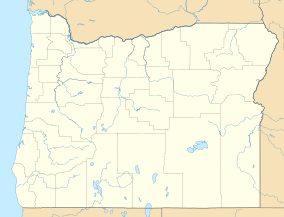Andrews Forest facts for kids
Quick facts for kids H.J. Andrews Experimental Forest |
|
|---|---|
|
IUCN Category IV (Habitat/Species Management Area)
|
|

Lookout Creek at the Andrews Forest (2005).
|
|
| Location | between Blue River and Belknap Springs, Lane and Linn, Oregon, United States |
| Area | 6,400 ha (25 sq mi) |
| Established | 1948 |
| Governing body | Oregon State University and United States Forest Service |
| Website | andrewsforest.oregonstate.edu |
The H.J. Andrews Experimental Forest, often called Andrews Forest, is a special place in Oregon, USA. It is managed by the United States Forest Service and Oregon State University. This forest is a Long Term Ecological Research (LTER) site. This means scientists study the forest for many years. It is located in the middle of the Western Cascades mountains.
The forest has a big difference in height, about 1300 meters (4,265 feet). The lowest part is near the main buildings. The highest point is at the top of Carpenter Mountain. Some parts of the forest have a lot of rain, like a temperate rainforest. About 40% of the forest is covered in old-growth forest, which means it has very old trees.
Contents
What is the Andrews Forest For?
The main goal of the H.J. Andrews Experimental Forest is to support research. Scientists study forests, streams, and watersheds here. They also want to help connect science, education, and how we manage nature.
The forest was set up in 1948 by the US Forest Service. In 1976, it became a Biosphere Reserve as part of a United Nations program. In 1980, it became one of the first sites in the National Science Foundation's Long-Term Ecological Research (LTER) Program.
History of Research at Andrews Forest
The Andrews Forest is named after Horace Justin Andrews, who was a forester. Over the years, the research done here has changed.
Early Studies (1950s-1970s)
In the 1950s and 1960s, scientists looked at how forest management affected things. They studied how cutting down trees or using controlled fires changed streams and water quality. In the 1970s, they focused on how the forest and stream ecosystems worked. They were especially interested in old-growth forests.
New Topics (1980s-2000s)
In the 1980s, research continued on basic forest workings. They also started studying how to grow trees, wildlife, and how different parts of the landscape connect. In the 1990s, there was a lot of focus on old-growth forests and the Northern spotted owl. More recently, with worries about climate change, scientists are studying how the forest changes over long periods. They also look at how mountains affect the forest's response to climate changes.
Current Research Projects
The Andrews Forest has many ongoing research projects. These projects help us understand how forests work.
Key Research Areas
Scientists study how land use, natural events like fires, and climate change affect the forest. They look at how carbon and nutrients move through the ecosystem. They also study how different plants and animals live together.
Some current projects include:
- DIRT: This project studies how dead plants and animals break down.
- BmM: This group looks at how the atmosphere interacts with the forest.
- Veg: This group surveys all the plants in the forest.
- Bird Survey: Scientists count birds, including the Northern spotted owl.
- Log Decomposition: This is a 200-year experiment to see how logs break down over a very long time.
Learning and Sharing
The Andrews Forest Program also helps people learn about the forest. They have many activities to share what they learn.
Programs for Students
- College Classes: Students from colleges and universities visit the forest. They take field courses and do research.
- K-12 Programs: Programs help teachers learn how to do real science projects with their students. Middle school students can visit and study the forest up close. They even get to study the forest canopy (the top part of the trees)!
Connecting Science and Art
The Andrews Forest believes that science is not the only way to understand nature. Since 2002, they have a special program called LTEReflections. This program brings in poets, writers, and thinkers. They spend time in the forest and write about their experiences. This helps people connect with nature in new ways.



